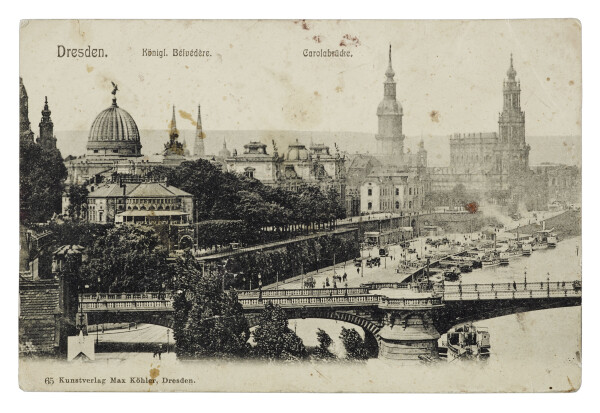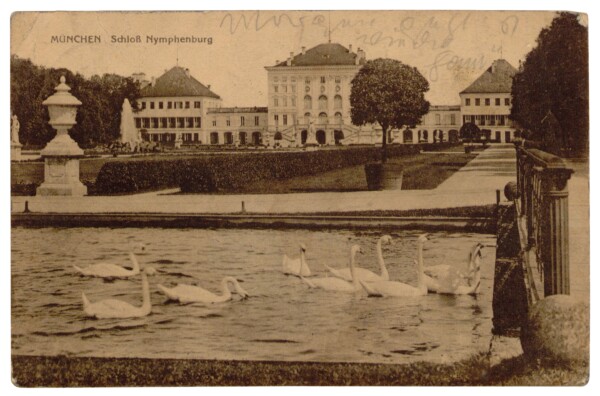Germany

Johannes Poppel, Georg Michael Kurz: Glass Palace in Munich, around 1855, Munich City Museum, Collection of Prints and Drawings / Paintings
© Münchner Stadtmuseum, Sammlung Reklamekunst

Gustav Klimt: Letter with Envelope from Gustav Klimt in Munich to Emilie Flöge in Vienna, 06/03/1897, Leopold Privatsammlung
© Leopold Museum, Vienna
Gustav Klimt repeatedly traveled to Germany for professional reasons. Newspaper articles, numerous surviving postcards to his family and friends, and a brisk correspondence with Emilie Flöge document several stays in Munich, Berlin, and Dresden.
Königssee and Munich (1888 and 1889)
Gustav Klimt mentioned trips to Germany for the first time in a personally penned biography. In 1888 he visited the Königsee in the company of his brother Ernst and fellow artist Franz Matsch, and he traveled to Munich the following year.
Visit of the Glass Palace and the Munich Secession (1898)
After a short and, according to Gustav Klimt, unadventurous stay at the Hotel Leinfelder in Munich in June 1897, the artist sojourned in Munich again for some time in the early fall of 1898, when he stayed at the Hotel Rheinischer Hof near the main station. During his second stay, he wrote a letter to his confidante Emilie Flöge on 3 September 1898. This letter reveals that Klimt had, for unknown reasons, met with the secretary of the Vienna Secession, Franz Hancke, and subsequently with Carl Moll. Klimt also wrote about a chance meeting in the morning with Arthur Scala, who had only recently taken over as director of the Austrian Museum of Art and Industry. In said letter, Klimt critically mentioned his visits to exhibitions at the Glass Palace and the Munich Secession:
“[I] was at the Glass Palace then to see the Union’s exhibition, it’s ghastly […] apart from a few exception, including Klinger’s ‘Christ on Mount Olympus’– the ‘Secession’ in the afternoon, which is far better, but not on top form either.”
Klimt also mentioned his trip to the surroundings of Munich, where he visited the Dachau colony of painters. He found the landscape inspiring; however, he was irritated by the crowd of painters gathering there. According to his message to Emilie Flöge, Klimt set off on his return journey to Vienna via Salzburg on the evening of 3 September, the day the letter was written.

Thomas Theodor Heine: Poster of the second exhibition of the Deutscher Künstlerbund in Berlin, 1905, Museum für Kunst und Gewerbe
© Museum für Kunst und Gewerbe Hamburg

Gustav Klimt: Picture postcard from Gustav Klimt in Dresden to Maria Ucicka in Vienna, 05/11/1906, Klimt Foundation
© Klimt Foundation, Vienna

Gustav Klimt: Picture postcard from Gustav Klimt in Berlin to Emilie Flöge in Vienna, 11/11/1907, private collection
© Leopold Museum, Vienna
Exhibition of the Union of German Artists in Berlin (1905)
In May 1905, Gustav Klimt took part in the opening of the “II. Ausstellung des Deutschen Künstlerbundes” [“2nd Exhibition of the Union of German Artists”] in the new Secession building in Berlin. There he presented thirteen of his paintings, including The Three Ages of Woman (1905, Galleria Nazionale d’Arte Moderna e Contemporanea, Rome):
“Today, at the exhibition of the Union of German Artists, the room accommodating Klimt’s works was accessible as well. Given today’s opening, this room was particularly crowded, and the Viennese artist was a full success with the Berlin audience.”
On 20 May 1905, the Neue Freie Presse also reported that at the opening a jury had awarded prizes to Gustav Klimt and two other artists in the exhibition. The prizewinners were offered to move into a studio for a year that was provided by the Union of German Artists at the Villa Romana in Florence. However, as an alternative the artists were allowed to forego this offer in favor of another artist. Gustav Klimt took advantage of this possibility, which ultimately enabled Maximilian Kurzweil to stay in Italy.
In 1943, Carl Moll reported in the Neues Wiener Tagblatt about a breakfast “given by Berlin’s leading artist in Klimt’s honor [...].” According to Moll, he had asked Klimt to paint a portrait of his daughter in May 1905, but Klimt declined because he saw himself unable to work in Berlin: “the young lady should come to Vienna.” His stay in Berlin, which lasted several days, is otherwise only documented by three postcards he sent to Emilie Flöge. The most informative message is the one sent on 19 May 1905: Klimt wrote that he had received his “crate” late, as there had been problems with it at the border.
Stopovers in Berlin and Dresden (1906)
On his return journey from London to Vienna in May 1906, Klimt and his travel companions stopped over in Berlin and Dresden. Both Emilie Flöge and Klimt’s mistress, Maria Ucicka, received a postcard each from Dresden. On the following day, the painter informed both of them of his planned arrival in Vienna.
Journey to Berlin (1907)
In November 1907, Gustav Klimt traveled to Berlin once more to stay there for a few days. Although he sent Emilie Flöge several picture postcards, he was rather reticent about his experiences. His messages essentially only reveal that he attended meetings, went to the theater, made an excursion to the Grunewald forest and visited the German architect Hermann Muthesius. He himself summed up his lack of talkativeness shortly before his departure from Berlin: “Coverage was meager.”

Gustav Klimt: Picture postcard from Gustav Klimt in Munich to Emilie Flöge in Kammer am Attersee, 07/12/1908, private collection
© Leopold Museum, Vienna
Founding Congress of the German Werkbund (1908)
In July 1908, Klimt traveled to Munich again, this time staying at the Hotel Vier Jahreszeiten. The reason for his stay was the founding congress of the Union of German Artists, which lasted several days and which he attended together with Josef Hoffmann, Otto Prutscher, Fritz Waerndorfer, and Bertold Löffler as delegated artists from Vienna. According to his correspondence with Emilie Flöge, who was staying at Villa Oleander on the Attersee at the time, he had miscalculated his travel arrangements for Munich and the Attersee, where he intended to travel afterwards:
“Yesterday I was hard-pressed for time – the devil knows what I packed into my bags, and I had resolved to bring less this time – yesterday’s card was probably illegible. It was written in such a rush.”
Over the next few days, Gustav Klimt reported on numerous visits to exhibitions and the theater. The painter also wrote about his physical discomfort, writing: “I think I’ve become fat – I’m coming back from Munich (still) unshaven and ‘scrubby.’” Klimt left Munich before the congress ended. Shortly before his departure on 13 July 1908 he informed Emilie Flöge of his planned arrival time and sent warm greetings to Maria Ucicka.

Gustav Klimt: Picture Postcard from Gustav Klimt in Munich to Julius Zimpel sen. in Vienna, 09/14/1910, The Albertina Museum
© The ALBERTINA Museum, Vienna
Greetings from Munich (1910)
Gustav Klimt stayed in the Bavarian capital for a few days in mid-September 1910 together with family members and friends. It is documented that he attended a performance of Gustav Mahler's Symphony No. VIII as part of the ‘Munich 1910 Exhibition’ together with Alma Mahler, Kolo Moser, Editha Moser, Adele Bloch-Bauer, Alfred Roller, Max Reinhardt, Anna Moll, Josef Maria Auchentaller and Carl Otto Czeschka. Further evidence of the journey are two picture postcards that he sent to Vienna with warm greetings to Hermann Flöge Jr. and to his brother-in-law or nephew - both named Julius Zimpel.
A Journey to Hamburg that never Took Place
According to Carl Moll’s accounts, which were published in the Neues Wiener Tagblatt in 1943, the director of the Hamburger Kunsthalle, Alfred Lichtwark, wished to offer Gustav Klimt a studio in Hamburg. He had already met the artist in person. In one of his letters of May 1905, Lichtwark described Klimt as follows:
“He is stout, rather plump […]. Probably to make his face longer, he wears his hair somewhat too high above the temples. […] When he speaks, his voice sounds loud, and he has a strong dialect. He loves to tease, and lustily at that.”
A surviving exchange of letters between Moll and Lichtwark from 1910 provides information about said proposal. Lichtwark asked Moll to act as a mediator in this matter, as he had received no reply from Klimt. According to Carl Moll, Gustav Klimt ultimately rejected the proposal, “because Klimt imagined that he could only work in his familiar surroundings.” No other documents in this matter are known to date.
Literature and sources
- Sandra Tretter, Peter Weinhäupl (Hg.): Chiffre: Sehnsucht – 25. Gustav Klimts Korrespondenz an Maria Ucicka 1899–1916, Vienna 2014.
- Agnes Husslein-Arco, Alfred Weidinger (Hg.): Gustav Klimt 150 Jahre, Ausst.-Kat., Upper Belvedere (Vienna), 13.07.2012–27.01.2013, Vienna 2012.
- Tobias G. Natter, Franz Smola, Peter Weinhäupl (Hg.): Klimt persönlich. Bilder – Briefe – Einblicke, Ausst.-Kat., Leopold Museum (Vienna), 24.02.2012–27.08.2012, Vienna 2012.
- Tobias G. Natter (Hg.): Gustav Klimt. Sämtliche Gemälde, Vienna 2012.
- Alfred Weidinger (Hg.): Gustav Klimt, Munich - Berlin - London - New York 2007.
- Christian M. Nebehay: Gustav Klimt. Sein Leben nach zeitgenössischen Berichten und Quellen, Vienna 1969.
- Keller, Reiner (Hg.): Erste gemeinsame Ausstellung der vielumstrittenen Monumentalwerke Philosophie, Medizin, Jurisprudenz von Gustav Klimt, Berlin 1907.
- Neue Freie Presse (Morgenausgabe), 20.05.1905, S. 9.
- Neues Wiener Journal, 11.07.1908, S. 8.
- Die Zeit, 17.07.1908, S. 4.
- Neues Wiener Tagblatt, 17.07.1908, S. 14.
- Neues Wiener Tagblatt, 24.01.1943, S. 3.
- Eintrittskarte zur »Ausstellung München 1910« unterschrieben von Gustav Klimt, Alma Mahler, Kolo Moser, Editha Moser, Adele Bloch-Bauer, Alfred Roller, Max Reinhardt, Anna Moll, Josef Maria Auchentaller und Carl Otto Czeschka (13.09.1910). MKG Archiv, NL Czeschka, Bestand Angelika Spielmann Karton 13 A, Mappe 5_2.
- Ansichtskarte von Gustav Klimt in München an Hermann Flöge jun. in Wien, mitunterschrieben von Emma Bacher, Emilie Flöge, Helene Klimt jun. und Wilhelm von Hackländer, LGM 31/16 (14.09.1910), .
- Ansichtskarte von Gustav Klimt in München an Julius Zimpel sen. in Wien (14.09.1910). GKA65.

